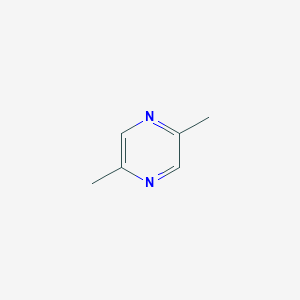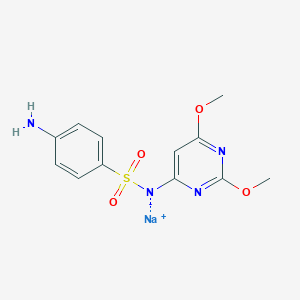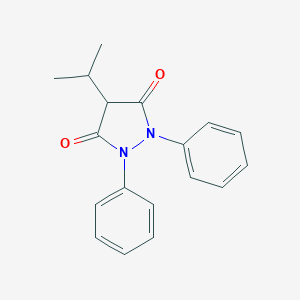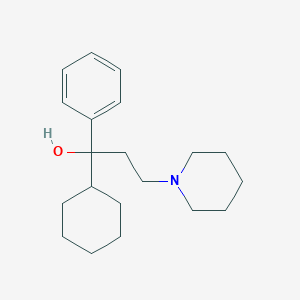
Trihexyphenidyl
Vue d'ensemble
Description
Le trihexyphenidyl est un médicament antispasmodique synthétique principalement utilisé pour gérer les symptômes de la maladie de Parkinson et les réactions extrapyramidales induites par les médicaments. Il appartient à la classe des médicaments anticholinergiques et est connu pour sa capacité à soulager la rigidité, les tremblements, les spasmes et le manque de contrôle musculaire . Le this compound a été approuvé pour la première fois par la FDA en 1949 et est depuis devenu un outil précieux dans le traitement symptomatique de diverses formes de parkinsonisme .
Méthodes De Préparation
La synthèse du trihexyphenidyl implique plusieurs étapes clés :
Synthèse du chlorhydrate de propiophénone pipéridyle intermédiaire : Cet intermédiaire est préparé par aminométhylation de l’acétophénone en utilisant du paraformaldéhyde et de la pipéridine dans une réaction de Mannich.
Formation de chlorhydrate de this compound brut : L’intermédiaire est ensuite mis à réagir avec un réactif de Grignard, en utilisant généralement de l’éther méthylique tertiaire butylique comme solvant pour éviter les problèmes de sécurité associés à l’éther diéthylique.
Raffinement : Le produit brut est raffiné pour obtenir du chlorhydrate de this compound pur.
Analyse Des Réactions Chimiques
Le trihexyphenidyl subit diverses réactions chimiques, notamment :
Oxydation : Il peut être oxydé dans des conditions spécifiques, bien que ce ne soit pas une réaction courante pour son utilisation thérapeutique.
Réduction : Les réactions de réduction sont moins courantes, mais peuvent être réalisées dans des conditions de laboratoire contrôlées.
Substitution : Le this compound peut subir des réactions de substitution, en particulier impliquant son cycle pipéridine.
Les réactifs couramment utilisés dans ces réactions comprennent des agents oxydants comme le permanganate de potassium et des agents réducteurs comme l’hydrure de lithium aluminium. Les principaux produits formés dépendent des conditions de réaction et des réactifs spécifiques utilisés.
4. Applications de la recherche scientifique
Le this compound a un large éventail d’applications de recherche scientifique :
Applications De Recherche Scientifique
Trihexyphenidyl has a wide range of scientific research applications:
Chemistry: It is used as a reference compound in analytical chemistry for method development and validation.
Biology: Research has explored its effects on metabolism, neurobehavioral patterns, and gut microbiome feedback loops
Industry: It is used in the pharmaceutical industry for the development of antispasmodic medications.
Mécanisme D'action
Le trihexyphenidyl exerce ses effets en agissant comme un antagoniste non sélectif des récepteurs muscariniques de l’acétylcholine, avec une affinité plus élevée pour le sous-type M1 . Il inhibe le système nerveux parasympathique, ce qui entraîne une réduction de la rigidité musculaire et des tremblements. Le médicament a également un effet spasmolytique direct sur les muscles lisses et présente des effets mydriatiques, antisalivatoires et de blocage cardiovagal faibles .
Comparaison Avec Des Composés Similaires
Le trihexyphenidyl est souvent comparé à d’autres agents anticholinergiques tels que :
Benztropine : Similaire dans ses effets anticholinergiques, mais avec des propriétés pharmacocinétiques différentes.
Diphenhydramine : Un antihistaminique aux propriétés anticholinergiques, utilisé pour des indications similaires, mais avec un éventail d’applications plus large.
Le this compound est unique en son genre en raison de son affinité spécifique pour les récepteurs muscariniques centraux, ce qui le rend particulièrement efficace pour gérer les symptômes liés au système nerveux central .
Propriétés
IUPAC Name |
1-cyclohexyl-1-phenyl-3-piperidin-1-ylpropan-1-ol | |
|---|---|---|
| Source | PubChem | |
| URL | https://pubchem.ncbi.nlm.nih.gov | |
| Description | Data deposited in or computed by PubChem | |
InChI |
InChI=1S/C20H31NO/c22-20(18-10-4-1-5-11-18,19-12-6-2-7-13-19)14-17-21-15-8-3-9-16-21/h1,4-5,10-11,19,22H,2-3,6-9,12-17H2 | |
| Source | PubChem | |
| URL | https://pubchem.ncbi.nlm.nih.gov | |
| Description | Data deposited in or computed by PubChem | |
InChI Key |
HWHLPVGTWGOCJO-UHFFFAOYSA-N | |
| Source | PubChem | |
| URL | https://pubchem.ncbi.nlm.nih.gov | |
| Description | Data deposited in or computed by PubChem | |
Canonical SMILES |
C1CCC(CC1)C(CCN2CCCCC2)(C3=CC=CC=C3)O | |
| Source | PubChem | |
| URL | https://pubchem.ncbi.nlm.nih.gov | |
| Description | Data deposited in or computed by PubChem | |
Molecular Formula |
C20H31NO | |
| Source | PubChem | |
| URL | https://pubchem.ncbi.nlm.nih.gov | |
| Description | Data deposited in or computed by PubChem | |
Related CAS |
52-49-3 (hydrochloride) | |
| Record name | Trihexyphenidyl [INN:BAN] | |
| Source | ChemIDplus | |
| URL | https://pubchem.ncbi.nlm.nih.gov/substance/?source=chemidplus&sourceid=0000144116 | |
| Description | ChemIDplus is a free, web search system that provides access to the structure and nomenclature authority files used for the identification of chemical substances cited in National Library of Medicine (NLM) databases, including the TOXNET system. | |
DSSTOX Substance ID |
DTXSID4023705 | |
| Record name | Trihexyphenidyl | |
| Source | EPA DSSTox | |
| URL | https://comptox.epa.gov/dashboard/DTXSID4023705 | |
| Description | DSSTox provides a high quality public chemistry resource for supporting improved predictive toxicology. | |
Molecular Weight |
301.5 g/mol | |
| Source | PubChem | |
| URL | https://pubchem.ncbi.nlm.nih.gov | |
| Description | Data deposited in or computed by PubChem | |
Physical Description |
Solid | |
| Record name | Trihexyphenidyl | |
| Source | Human Metabolome Database (HMDB) | |
| URL | http://www.hmdb.ca/metabolites/HMDB0014520 | |
| Description | The Human Metabolome Database (HMDB) is a freely available electronic database containing detailed information about small molecule metabolites found in the human body. | |
| Explanation | HMDB is offered to the public as a freely available resource. Use and re-distribution of the data, in whole or in part, for commercial purposes requires explicit permission of the authors and explicit acknowledgment of the source material (HMDB) and the original publication (see the HMDB citing page). We ask that users who download significant portions of the database cite the HMDB paper in any resulting publications. | |
Solubility |
Crystals; decomp at 258.5 °C; pH of 1% aq soln 5.5-6.0; solubility (g/100 mL): water at 25 °C 1.0, alcohol 6, chloroform 5; more soluble in methanol; very slightly soluble in ether, benzene /Hydrochloride/, 3.14e-03 g/L | |
| Record name | TRIHEXYPHENIDYL | |
| Source | Hazardous Substances Data Bank (HSDB) | |
| URL | https://pubchem.ncbi.nlm.nih.gov/source/hsdb/3196 | |
| Description | The Hazardous Substances Data Bank (HSDB) is a toxicology database that focuses on the toxicology of potentially hazardous chemicals. It provides information on human exposure, industrial hygiene, emergency handling procedures, environmental fate, regulatory requirements, nanomaterials, and related areas. The information in HSDB has been assessed by a Scientific Review Panel. | |
| Record name | Trihexyphenidyl | |
| Source | Human Metabolome Database (HMDB) | |
| URL | http://www.hmdb.ca/metabolites/HMDB0014520 | |
| Description | The Human Metabolome Database (HMDB) is a freely available electronic database containing detailed information about small molecule metabolites found in the human body. | |
| Explanation | HMDB is offered to the public as a freely available resource. Use and re-distribution of the data, in whole or in part, for commercial purposes requires explicit permission of the authors and explicit acknowledgment of the source material (HMDB) and the original publication (see the HMDB citing page). We ask that users who download significant portions of the database cite the HMDB paper in any resulting publications. | |
Mechanism of Action |
Trihexyphenidyl is a non-selective muscarinic acetylcholine receptor antagonist but binds with higher affinity to the M1 subtype. In vivo studies have shown that trihexyphenidyl demonstrates higher affinity for central muscarinic receptors located in the cerebral cortex and lower affinity for those located peripherally. Other studies suggest that trihexyphenidyl may modify nicotinic acetylcholine receptor neurotransmission, leading indirectly to enhanced dopamine release in the striatum. Although the anticholinergic has proven to be useful in the treatment of symptoms associated with Parkinson’s disease or other movement disorders, its mechanism of action has yet to be fully elucidated., Cerebral blood flow and oxygen metabolism were studied in six previously untreated patients with Parkinson's disease (PD) before and after anticholinergic treatment using positron emission tomography (PET) and compared with six controls. The PET study and an assessment of the disability and cognitive impairment were performed before and after administration of 6 mg trihexyphenidyl for 5 to 11 weeks. All PD patients showed improvements in motor symptoms after the trihexyphenidyl treatment. Cognitive function did not significantly differ between before and after trihexyphenidyl treatment. However, after trihexyphenidyl treatment, regional cerebral blood flow (rCBF) and regional oxygen metabolic rate (rCMRO2) decreased by 15% in the striatum and by 10% in all cortical areas contralateral to predominantly symptomatic limbs, and by 10% in the ipsilateral striatum and all cortical areas, significantly below the values of controls in most cerebral cortices and striatum. These findings suggest that trihexyphenidyl inhibits the cortical cholinergic system and significantly decreases rCBF and rCMRO2 in the cerebral cortices without cognitive impairment in untreated patients with PD., In common with other antimuscarinic agents, trihexyphenidyl produces an atropine-like blocking action on parasympathetic-innervated peripheral structures, including smooth muscle. In addition, trihexyphenidyl exhibits a direct spasmolytic action on smooth muscle and exhibits weak mydriatic, antisialagogue, and cardiovagal blocking effects. The exact mechanism of action of trihexyphenidyl in parkinsonian syndrome is not understood but may result from blockade of efferent impulses and from central inhibition of cerebral motor centers. In small doses, trihexyphenidyl depresses the CNS but larger doses cause cerebral excitement resembling the signs of atropine toxicity., In vivo microdialysis was used to study the effect of the non-selective muscarinic antagonist, trihexyphenidyl, on the decarboxylation of levodopa (L-dopa) in the striatum of hemi-Parkinson rats. In normal rats, continuous perfusion of trihexyphenidyl (1 mM) via the microdialysis probe induced a significant increase in striatal dopamine release, followed by a decrease to below baseline values. A similar effect was observed, though less pronounced, in denervated striatum of rats with a unilateral 6-hydroxydopamine lesion of the nigrostriatal pathway. In these hemi-Parkinson rats, continuous striatal perfusion of trihexyphenidyl had no effect on the biotransformation of locally applied L-dopa (2 uM for 20 min) to dopamine in either intact or denervated striatum. However, systemic administration of trihexyphenidyl (1.5 mg/kg ip) produced an attenuation of the L- dopa-induced dopamine release in the intact striatum (contralateral to the lesion) of hemi-Parkinson rats. This effect was absent in the denervated striatum of these animals. We confirmed that L-dopa induces an increase in striatal dopamine output which is influenced by the severity of the dopaminergic denervation. The absence of an effect of trihexyphenidyl locally applied in the striatum, on biotransformation of L-dopa suggests that the site of action of antimuscarinic drugs may not be in the striatum and, therefore, remains unclear. | |
| Record name | Trihexyphenidyl | |
| Source | DrugBank | |
| URL | https://www.drugbank.ca/drugs/DB00376 | |
| Description | The DrugBank database is a unique bioinformatics and cheminformatics resource that combines detailed drug (i.e. chemical, pharmacological and pharmaceutical) data with comprehensive drug target (i.e. sequence, structure, and pathway) information. | |
| Explanation | Creative Common's Attribution-NonCommercial 4.0 International License (http://creativecommons.org/licenses/by-nc/4.0/legalcode) | |
| Record name | TRIHEXYPHENIDYL | |
| Source | Hazardous Substances Data Bank (HSDB) | |
| URL | https://pubchem.ncbi.nlm.nih.gov/source/hsdb/3196 | |
| Description | The Hazardous Substances Data Bank (HSDB) is a toxicology database that focuses on the toxicology of potentially hazardous chemicals. It provides information on human exposure, industrial hygiene, emergency handling procedures, environmental fate, regulatory requirements, nanomaterials, and related areas. The information in HSDB has been assessed by a Scientific Review Panel. | |
Impurities |
1-phenyl-3-(piperidine-1-yl)propan-1-one | |
| Record name | TRIHEXYPHENIDYL | |
| Source | Hazardous Substances Data Bank (HSDB) | |
| URL | https://pubchem.ncbi.nlm.nih.gov/source/hsdb/3196 | |
| Description | The Hazardous Substances Data Bank (HSDB) is a toxicology database that focuses on the toxicology of potentially hazardous chemicals. It provides information on human exposure, industrial hygiene, emergency handling procedures, environmental fate, regulatory requirements, nanomaterials, and related areas. The information in HSDB has been assessed by a Scientific Review Panel. | |
CAS No. |
144-11-6 | |
| Record name | (±)-Trihexyphenidyl | |
| Source | CAS Common Chemistry | |
| URL | https://commonchemistry.cas.org/detail?cas_rn=144-11-6 | |
| Description | CAS Common Chemistry is an open community resource for accessing chemical information. Nearly 500,000 chemical substances from CAS REGISTRY cover areas of community interest, including common and frequently regulated chemicals, and those relevant to high school and undergraduate chemistry classes. This chemical information, curated by our expert scientists, is provided in alignment with our mission as a division of the American Chemical Society. | |
| Explanation | The data from CAS Common Chemistry is provided under a CC-BY-NC 4.0 license, unless otherwise stated. | |
| Record name | Trihexyphenidyl [INN:BAN] | |
| Source | ChemIDplus | |
| URL | https://pubchem.ncbi.nlm.nih.gov/substance/?source=chemidplus&sourceid=0000144116 | |
| Description | ChemIDplus is a free, web search system that provides access to the structure and nomenclature authority files used for the identification of chemical substances cited in National Library of Medicine (NLM) databases, including the TOXNET system. | |
| Record name | Trihexyphenidyl | |
| Source | DrugBank | |
| URL | https://www.drugbank.ca/drugs/DB00376 | |
| Description | The DrugBank database is a unique bioinformatics and cheminformatics resource that combines detailed drug (i.e. chemical, pharmacological and pharmaceutical) data with comprehensive drug target (i.e. sequence, structure, and pathway) information. | |
| Explanation | Creative Common's Attribution-NonCommercial 4.0 International License (http://creativecommons.org/licenses/by-nc/4.0/legalcode) | |
| Record name | trihexyphenidyl | |
| Source | DTP/NCI | |
| URL | https://dtp.cancer.gov/dtpstandard/servlet/dwindex?searchtype=NSC&outputformat=html&searchlist=12268 | |
| Description | The NCI Development Therapeutics Program (DTP) provides services and resources to the academic and private-sector research communities worldwide to facilitate the discovery and development of new cancer therapeutic agents. | |
| Explanation | Unless otherwise indicated, all text within NCI products is free of copyright and may be reused without our permission. Credit the National Cancer Institute as the source. | |
| Record name | Trihexyphenidyl | |
| Source | EPA DSSTox | |
| URL | https://comptox.epa.gov/dashboard/DTXSID4023705 | |
| Description | DSSTox provides a high quality public chemistry resource for supporting improved predictive toxicology. | |
| Record name | Trihexyphenidyl | |
| Source | European Chemicals Agency (ECHA) | |
| URL | https://echa.europa.eu/substance-information/-/substanceinfo/100.005.105 | |
| Description | The European Chemicals Agency (ECHA) is an agency of the European Union which is the driving force among regulatory authorities in implementing the EU's groundbreaking chemicals legislation for the benefit of human health and the environment as well as for innovation and competitiveness. | |
| Explanation | Use of the information, documents and data from the ECHA website is subject to the terms and conditions of this Legal Notice, and subject to other binding limitations provided for under applicable law, the information, documents and data made available on the ECHA website may be reproduced, distributed and/or used, totally or in part, for non-commercial purposes provided that ECHA is acknowledged as the source: "Source: European Chemicals Agency, http://echa.europa.eu/". Such acknowledgement must be included in each copy of the material. ECHA permits and encourages organisations and individuals to create links to the ECHA website under the following cumulative conditions: Links can only be made to webpages that provide a link to the Legal Notice page. | |
| Record name | TRIHEXYPHENIDYL | |
| Source | FDA Global Substance Registration System (GSRS) | |
| URL | https://gsrs.ncats.nih.gov/ginas/app/beta/substances/6RC5V8B7PO | |
| Description | The FDA Global Substance Registration System (GSRS) enables the efficient and accurate exchange of information on what substances are in regulated products. Instead of relying on names, which vary across regulatory domains, countries, and regions, the GSRS knowledge base makes it possible for substances to be defined by standardized, scientific descriptions. | |
| Explanation | Unless otherwise noted, the contents of the FDA website (www.fda.gov), both text and graphics, are not copyrighted. They are in the public domain and may be republished, reprinted and otherwise used freely by anyone without the need to obtain permission from FDA. Credit to the U.S. Food and Drug Administration as the source is appreciated but not required. | |
| Record name | TRIHEXYPHENIDYL | |
| Source | Hazardous Substances Data Bank (HSDB) | |
| URL | https://pubchem.ncbi.nlm.nih.gov/source/hsdb/3196 | |
| Description | The Hazardous Substances Data Bank (HSDB) is a toxicology database that focuses on the toxicology of potentially hazardous chemicals. It provides information on human exposure, industrial hygiene, emergency handling procedures, environmental fate, regulatory requirements, nanomaterials, and related areas. The information in HSDB has been assessed by a Scientific Review Panel. | |
| Record name | Trihexyphenidyl | |
| Source | Human Metabolome Database (HMDB) | |
| URL | http://www.hmdb.ca/metabolites/HMDB0014520 | |
| Description | The Human Metabolome Database (HMDB) is a freely available electronic database containing detailed information about small molecule metabolites found in the human body. | |
| Explanation | HMDB is offered to the public as a freely available resource. Use and re-distribution of the data, in whole or in part, for commercial purposes requires explicit permission of the authors and explicit acknowledgment of the source material (HMDB) and the original publication (see the HMDB citing page). We ask that users who download significant portions of the database cite the HMDB paper in any resulting publications. | |
Melting Point |
114 °C, 258.5 °C | |
| Record name | Trihexyphenidyl | |
| Source | DrugBank | |
| URL | https://www.drugbank.ca/drugs/DB00376 | |
| Description | The DrugBank database is a unique bioinformatics and cheminformatics resource that combines detailed drug (i.e. chemical, pharmacological and pharmaceutical) data with comprehensive drug target (i.e. sequence, structure, and pathway) information. | |
| Explanation | Creative Common's Attribution-NonCommercial 4.0 International License (http://creativecommons.org/licenses/by-nc/4.0/legalcode) | |
| Record name | TRIHEXYPHENIDYL | |
| Source | Hazardous Substances Data Bank (HSDB) | |
| URL | https://pubchem.ncbi.nlm.nih.gov/source/hsdb/3196 | |
| Description | The Hazardous Substances Data Bank (HSDB) is a toxicology database that focuses on the toxicology of potentially hazardous chemicals. It provides information on human exposure, industrial hygiene, emergency handling procedures, environmental fate, regulatory requirements, nanomaterials, and related areas. The information in HSDB has been assessed by a Scientific Review Panel. | |
| Record name | Trihexyphenidyl | |
| Source | Human Metabolome Database (HMDB) | |
| URL | http://www.hmdb.ca/metabolites/HMDB0014520 | |
| Description | The Human Metabolome Database (HMDB) is a freely available electronic database containing detailed information about small molecule metabolites found in the human body. | |
| Explanation | HMDB is offered to the public as a freely available resource. Use and re-distribution of the data, in whole or in part, for commercial purposes requires explicit permission of the authors and explicit acknowledgment of the source material (HMDB) and the original publication (see the HMDB citing page). We ask that users who download significant portions of the database cite the HMDB paper in any resulting publications. | |
Retrosynthesis Analysis
AI-Powered Synthesis Planning: Our tool employs the Template_relevance Pistachio, Template_relevance Bkms_metabolic, Template_relevance Pistachio_ringbreaker, Template_relevance Reaxys, Template_relevance Reaxys_biocatalysis model, leveraging a vast database of chemical reactions to predict feasible synthetic routes.
One-Step Synthesis Focus: Specifically designed for one-step synthesis, it provides concise and direct routes for your target compounds, streamlining the synthesis process.
Accurate Predictions: Utilizing the extensive PISTACHIO, BKMS_METABOLIC, PISTACHIO_RINGBREAKER, REAXYS, REAXYS_BIOCATALYSIS database, our tool offers high-accuracy predictions, reflecting the latest in chemical research and data.
Strategy Settings
| Precursor scoring | Relevance Heuristic |
|---|---|
| Min. plausibility | 0.01 |
| Model | Template_relevance |
| Template Set | Pistachio/Bkms_metabolic/Pistachio_ringbreaker/Reaxys/Reaxys_biocatalysis |
| Top-N result to add to graph | 6 |
Feasible Synthetic Routes
Avertissement et informations sur les produits de recherche in vitro
Veuillez noter que tous les articles et informations sur les produits présentés sur BenchChem sont destinés uniquement à des fins informatives. Les produits disponibles à l'achat sur BenchChem sont spécifiquement conçus pour des études in vitro, qui sont réalisées en dehors des organismes vivants. Les études in vitro, dérivées du terme latin "in verre", impliquent des expériences réalisées dans des environnements de laboratoire contrôlés à l'aide de cellules ou de tissus. Il est important de noter que ces produits ne sont pas classés comme médicaments et n'ont pas reçu l'approbation de la FDA pour la prévention, le traitement ou la guérison de toute condition médicale, affection ou maladie. Nous devons souligner que toute forme d'introduction corporelle de ces produits chez les humains ou les animaux est strictement interdite par la loi. Il est essentiel de respecter ces directives pour assurer la conformité aux normes légales et éthiques en matière de recherche et d'expérimentation.


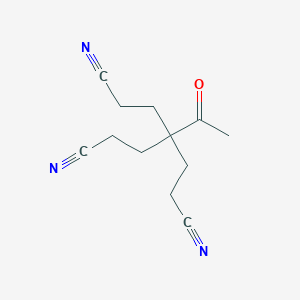
![1,4,6,9-Tetraoxa-5lambda~4~-telluraspiro[4.4]nonane](/img/structure/B89650.png)


